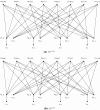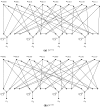Not all phylogenetic networks are leaf-reconstructible
- PMID: 31363828
- PMCID: PMC6800874
- DOI: 10.1007/s00285-019-01405-9
Not all phylogenetic networks are leaf-reconstructible
Abstract
Unrooted phylogenetic networks are graphs used to represent reticulate evolutionary relationships. Accurately reconstructing such networks is of great relevance for evolutionary biology. It has recently been conjectured that all unrooted phylogenetic networks for at least five taxa can be uniquely reconstructed from their subnetworks obtained by deleting a single taxon. Here, we show that this conjecture is false, by presenting a counter-example for each possible number of taxa that is at least 4. Moreover, we show that the conjecture is still false when restricted to binary networks. This means that, even if we are able to reconstruct the unrooted evolutionary history of each proper subset of some taxon set, this still does not give us enough information to reconstruct their full unrooted evolutionary history.
Keywords: Graph reconstruction; Leaf removal; Phylogenetic Networks; Phylogenetics; Ulam’s Conjecture; Undirected graphs.
Figures







Similar articles
-
Reconstructing Tree-Child Networks from Reticulate-Edge-Deleted Subnetworks.Bull Math Biol. 2019 Oct;81(10):3823-3863. doi: 10.1007/s11538-019-00641-w. Epub 2019 Jul 11. Bull Math Biol. 2019. PMID: 31297691 Free PMC article.
-
Exploring the Tiers of Rooted Phylogenetic Network Space Using Tail Moves.Bull Math Biol. 2018 Aug;80(8):2177-2208. doi: 10.1007/s11538-018-0452-0. Epub 2018 Jun 14. Bull Math Biol. 2018. PMID: 29948885 Free PMC article.
-
Bounds for phylogenetic network space metrics.J Math Biol. 2018 Apr;76(5):1229-1248. doi: 10.1007/s00285-017-1171-0. Epub 2017 Aug 23. J Math Biol. 2018. PMID: 28836230 Free PMC article.
-
Tree-based unrooted nonbinary phylogenetic networks.Math Biosci. 2018 Aug;302:131-138. doi: 10.1016/j.mbs.2018.06.005. Epub 2018 Jun 19. Math Biosci. 2018. PMID: 29932953
-
Molecular Phylogenetics: Concepts for a Newcomer.Adv Biochem Eng Biotechnol. 2017;160:185-196. doi: 10.1007/10_2016_49. Adv Biochem Eng Biotechnol. 2017. PMID: 27783136 Review.
References
MeSH terms
Grants and funding
LinkOut - more resources
Full Text Sources

